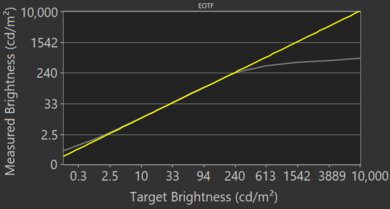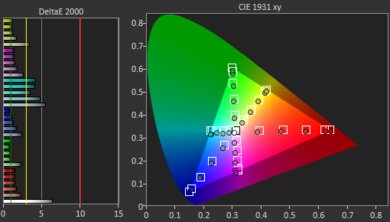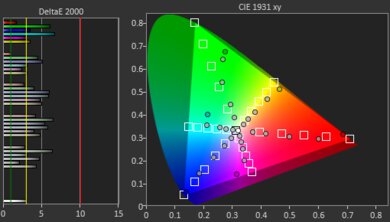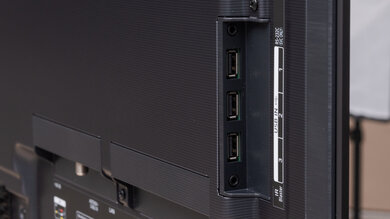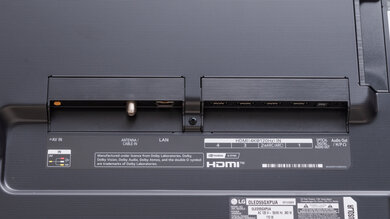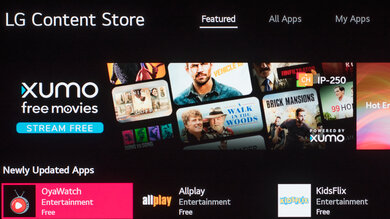The LG GX is a new TV in LG's 2020 lineup with a unique 'Gallery' design. It's a very thin TV that comes with a wall-mount instead of a stand, and it's meant to sit flush against the wall. Picture quality is excellent; like any OLED, it can individually dim pixels, resulting in an infinite contrast ratio and perfect black uniformity. It displays a wide color gamut for HDR content, but it has an aggressive Automatic Brightness Limiter, so large areas aren't bright. It has variable refresh rate (VRR) support, a near-instant response time, a Black Frame Insertion feature, and low input lag for gaming. Unfortunately, like any OLED, it has the risk of permanent burn-in, which can be an issue if you watch content with static elements all the time, like the news, but it shouldn't pose too much of a problem if you watch varied content. Lastly, it has wide viewing angles, which is great for wide seating arrangements.
Note: We bought the optional stand with the TV for testing and didn't use the included wall-mount. We've read reports of people having a hard time setting up the TV, but this isn't something we test for. If you experience any issues, let us know in the discussions. If you don't plan on wall-mounting it, the LG CX OLED is a very similar TV that comes with a stand and costs less.
Our Verdict
The LG GX OLED is an amazing all-around TV. It's an ideal choice for watching movies in a dark room because of its nearly infinite contrast ratio and perfect black uniformity. Gamers should enjoy the 120Hz refresh rate, VRR support, near-instant response time, and low input lag. It also has wide viewing angles if you want to watch the big game in a wide seating arrangement. Unfortunately, it has the risk of permanent burn-in, so it's not ideal to use as a PC monitor because of the static elements of most user interfaces.
- Nearly infinite contrast ratio.
- Wide viewing angles.
- Near-instant response time.
- VRR support.
- Aggressive Automatic Brightness Limiter (ABL).
- Risk permanent burn-in.
The LG GX OLED is an incredible TV for watching movies. It has a nearly infinite contrast ratio and perfect black uniformity, so movies in a dark room look amazing. It upscales lower-resolution content well, and it removes 24p judder from any source. Sadly, because this TV has a near-instant response time, lower frame rate content may appear to stutter.
- Nearly infinite contrast ratio.
- Perfect black uniformity.
- Removes 24p judder.
- Upscales 720p and 1080p content well.
- Low frame rate content may appear to stutter.
Great for TV shows. The LG GX has very wide viewing angles, great if you walk around while watching your favorite show. It has outstanding reflection handling but may not get bright enough to combat glare in well-lit environments. It upscales lower-resolution content, such as from cable boxes, without any problems. Unfortunately, it has the risk of permanent burn-in, which may be an issue if you constantly watch content with static elements, like the news.
- Upscales 720p and 1080p content well.
- Wide viewing angles.
- Outstanding reflection handling.
- Aggressive Automatic Brightness Limiter (ABL).
- Risk permanent burn-in.
The LG GX is excellent for watching sports. It has a near-instant response time, resulting in minimal motion blur, and it has wide viewing angles if you want to watch the game with a large group of friends. It performs well in bright rooms because it has outstanding reflection handling, but it doesn't get bright enough to combat a lot of glare. Our unit has a uniform screen with no dirty screen effect, but this may vary between units.
- Wide viewing angles.
- Outstanding reflection handling.
- Near-instant response time.
- Aggressive Automatic Brightness Limiter (ABL).
Outstanding for video games. The LG GX has a 120Hz refresh rate and VRR support to reduce screen tearing. Its response time is near-instant and it has a Black Frame Insertion feature. Input lag is also incredibly low. Also, it's amazing for dark-room gaming because of its nearly infinite contrast ratio. Sadly, it has the risk of permanent burn-in if you constantly play video games with an interface that has a lot of static elements, but we don't expect this to be an issue for most people.
- Near-instant response time.
- Low input lag.
- VRR support.
- Risk permanent burn-in.
Excellent for HDR movies. The LG GX has an infinite contrast ratio, displaying extremely deep blacks, and it has perfect black uniformity. It displays a wide color gamut for HDR, but it may not get bright enough in HDR to truly bring out highlights. Lower frame rate content may appear to stutter because of its near-instant response time. However, it can remove 24p judder from any source.
- Nearly infinite contrast ratio.
- Perfect black uniformity.
- Removes 24p judder.
- Displays wide color gamut.
- Aggressive Automatic Brightness Limiter (ABL).
- Risk permanent burn-in.
The LG GX is excellent for HDR gaming. It's packed with gaming features like VRR support, near-instant response time, and low input lag. HDR content looks good because it displays a wide color gamut, but it doesn't get very bright in that mode to truly make highlights stand out. Due to this TV's nearly infinite contrast ratio, it displays perfect blacks, great for dark-room gaming.
- Nearly infinite contrast ratio.
- Near-instant response time.
- Low input lag.
- Displays wide color gamut.
- Aggressive Automatic Brightness Limiter (ABL).
- Risk permanent burn-in.
The LG GX is an excellent choice to use as a PC monitor. It has wide viewing angles, low input lag, and near-instant response time. It also displays chroma 4:4:4, which is important for reading text. Sadly, it has the risk of permanent burn-in, so static elements from a computer's interface may damage the screen over time, but this shouldn't be a problem if you watch varied content.
- Wide viewing angles.
- Outstanding reflection handling.
- Low input lag.
- Aggressive Automatic Brightness Limiter (ABL).
- Risk permanent burn-in.
Changelog
- Updated May 06, 2022: We changed the subtype from WRGB to WOLED as it's more accurate and more consistent with other TVs.
- Updated Sep 16, 2021: We corrected a mistake in the total inputs section.
- Updated Jul 26, 2021: We added two local dimming videos with real content, and rechecked Dolby Vision support on the Xbox Series X.
- Updated Mar 01, 2021: Converted to Test Bench 1.6.
Check Price
Differences Between Sizes And Variants
We tested the 55 inch LG GX (OLED55GXPUA) and we expect our results to be valid for the 65 inch (OLED65GXPUA) and 77 inch (OLED77GXPUA) models too. You can see the different model numbers for the GX series between North America and Europe below.
| Size | North America | Europe |
| 55" | OLED55GXPUA | OLED55GX6LA |
| 65" | OLED65GXPUA | OLED65GX6LA |
| 77" | OLED77GXPUA | OLED77GX6LA |
If someone comes across a different type of panel or if their LG GX doesn't correspond to our review, let us know and we'll update the review. Note that some tests such as the gray uniformity may vary between individual units.
The GX we reviewed was manufactured in March 2020, and you can see the label here.
Popular TV Comparisons
The LG GX is an excellent TV and like most OLEDs, it delivers exceptional picture quality. However, it doesn't stand out much against the cheaper LG CX OLED, so if you need a stand or you simply want to VESA-mount the TV, the GX isn't worth it for its price. Also see our recommendations for the best 4k TVs, the best OLED TVs, and the best LG TVs.
In terms of picture quality, the LG GX OLED and the LG CX OLED are two very similar TVs and any differences come down to panel variance. Our unit of the CX has much better color accuracy, better gradient handling, and it gets slightly brighter. However, our unit of the GX has wider viewing angles. The major difference between them is that the GX comes with a wall mount that makes it sit flush against a wall, while the CX comes with a stand.
The LG GX OLED and the LG G2 OLED deliver a very similar experience. The G2 uses a newer OLED panel, which gets a lot brighter, especially in HDR, so bright highlights stand out better. On the other hand, the GX's black frame insertion feature is a bit more versatile, as it supports a 120Hz flicker with 120Hz content, whereas the G2 can only flicker at 60Hz.
The LG C9 OLED and the LG GX OLED are two similar TVs with different designs. The GX is meant to be wall-mounted and comes with a dedicated wall-mount instead of a stand. It also has a wider VRR range, a Black Frame Insertion feature that flickers at 120Hz, and better speakers. On the other hand, the C9 comes with a stand and has better out-of-the-box color accuracy, but this may vary between units.
The LG GX OLED and the LG C1 OLED offer very similar performance overall. The biggest difference between them is design. The GX is more of a statement piece, extremely thin, and designed to sit flush against the wall. It doesn't even come with a stand out of the box—you have to buy one separately. In terms of performance, both TVs have OLED panels with stunning picture quality, but the C1 comes with the latest version of webOS and a redesigned Magic Remote, along with a new gaming setting to reduce input lag further. Both are amazing TVs.

We buy and test dozens of TVs yearly, taking an objective, data-driven approach to deliver results you can trust. Our testing process is complex, with hundreds of individual tests that take over a week to complete. Most of our tests are done with specially designed test patterns that mimic real content, but we also use the same sources you have at home to ensure our results match the real-world experience. We use two main tools for our testing: a Colorimetry Research CR-100 colorimeter and a CR-250 spectroradiometer.
Test Results

The LG GX has an incredible design. It's very thin and the TV has a uniform thickness throughout. There are tapered edges where the front and back panels meet, which allows the TV to sit flush against the wall when wall-mounted, making it look like a picture frame. It comes with LG's Flush Wall Mount, and you can buy feet separately if you don't want to wall-mount it.
LG sells feet you can buy separately for this stand, which is what we did, and they hold the TV well. If you don't plan on wall-mounting it, then consider the LG CX OLED, which is a very similar TV that's cheaper and it comes with a stand.
Footprint of the 55" stand: 45.4" x 10.7".
Note: If you buy the feet separately you also get input covers.
The back of this TV is made out of metal. In the photo, there's a cover where the dedicated wall-mount goes, and you can also VESA-mount it if you choose. There's an L-shaped panel covering the inputs and it allows you to route wires to the center of the TV if you wall-mount it. There's also cable management through the optional feet.
Note: The input covers come with the feet if you buy them separately.
The LG GX is very thin and won't stick out when wall-mounted. It's even thinner than the Samsung The Frame 2020.
The LG GX has okay peak brightness. It gets bright enough to combat glare in moderately-lit rooms, but it may not be good enough for a bright environment. Because of its aggressive Automatic Brightness Limiter (ABL), its brightness isn't very consistent across different content and it quickly becomes dim with large, bright areas.
We measured peak brightness before calibration, although we normally take the results after calibration. This is because calibrating the TV significantly improved the 100% peak window up to 269 cd/m², while the other results only slightly improved by one or two nits. Since calibration changes per unit, not every TV would get brighter like ours, and some may get dimmer.
We measured the SDR peak brightness in the 'Expert (Dark Room)' Picture Mode with OLED Light at its max and Peak Brightness setting on 'High'. We got the brightest image possible with these settings, as seen in the 10% peak window test.
Update 07/26/2021: We've added two new videos demonstrating the backlight behavior with real content.
Since this TV doesn't have a backlight, it doesn't have a local dimming feature. It can dim pixels individually, so bright objects and subtitles are displayed perfectly, with no visible blooming.
Update 07/26/2021: We've added two new videos demonstrating the backlight behavior with real content.
Decent brightness in HDR. This TV gets bright enough to bring out small highlights in HDR. However, like in SDR, it quickly loses its brightness as large, bright areas cover the screen because of its aggressive ABL. If you want an OLED that gets a bit brighter in HDR, check out the Sony A90J OLED.
We measured HDR peak brightness in the 'HDR Cinema' Picture Mode with OLED Light at its max, Peak Brightness set to 'High', and Color Temperature set to 'Warm 2'.
If you want the brightest image possible, set the Picture Mode to 'HDR Vivid' with its default settings.
The LG GX has excellent gray uniformity. There's very minor dirty screen effect in the center, but it shouldn't be distracting during sports. However, like most OLED TVs, there are faint vertical and horizontal lines that may be visible in near-dark scenes.
Note: Gray uniformity may vary between units.
Just like the LG CX OLED, the LG GX has outstanding reflection handling. You shouldn't have any issues placing this opposite a window.
Update 12/08/2020: We remeasured the accuracy after calibrating our spectroradiometer. The review has been updated.
Decent out-of-the-box color accuracy. Most colors are slightly inaccurate and white balance is off, which affects shades of gray. The color temperature is slightly cold and for the most part, gamma follows the target curve well, except extremely bright scenes may be too bright.
We had to calibrate the TV twice because we had difficulty calibrating the 5% and 10% gray stimulus levels while being connected to HDMI 1. We calibrated it again through HDMI 2, so these results are taken from HDMI 2. The color accuracy only slightly improved and you can see our original results from HDMI 1 here:
- White Balance dE: 4.94
- Color dE: 3.09
- Gamma: 2.12
- Color Temperature: 5972K
- White Balance Photo
- Gamma Photo
- Color Space Photo
Note: Color accuracy may vary between units.
If you want a high-end TV with exceptional accuracy out of the box, check out the Samsung QN85A QLED.
After calibration, color accuracy is almost perfect. Any remaining inaccuracies are almost impossible to spot with the naked eye and the color temperature is extremely close to the 6500K target.
We originally calibrated the LG GX through HDMI 1. While trying to calibrate the 10% gray stimulus, it heavily affected the 5% gray stimulus to the point where the screen looked blue. This made it difficult to get a proper image post-calibration. We recalibrated it a second time on HDMI 2, and even though it slightly decreased the final score, it resulted in a better final image. You can see our original results here:
- Score: 9.5
- White Balance dE: 0.34
- Color dE: 1.14
- Gamma: 2.19
- Color Temperature: 6497K
- White Balance Photo
- Gamma Photo
- Color Space Photo
You can see our recommended settings here.
The LG GX has an RGBW pixel structure, but all four pixels are never used at the same time. The image above shows the white, blue, and green subpixels. You can see alternate pixel pictures here: Photo 1 and Photo 2. This pixel structure isn't ideal for use as a PC monitor because it affects the way text is displayed.
Excellent color gamut. This TV has near-perfect coverage of the DCI P3 color space used in most HDR content and decent coverage of the wider Rec. 2020 color space.
The EOTF follows the target curve fairly well until it rolls off at its peak brightness. The EOTF in 'Game' mode is almost the exact same.
If you find HDR too dim, enable Dynamic Tone Mapping and set Dynamic Contrast to 'Medium'. It resulted in a bit brighter image, as you can see in this EOTF.
Okay color volume. Thanks to its nearly infinite contrast ratio, it displays deep, saturated colors well. However, it struggles to display brighter colors.
Good gradient handling, but it's not as good as the LG CX OLED. There's noticeable banding in grays and greens and a bit in reds and blues. Setting Smooth Gradation to 'High' helps smooths out gradients in real content, but it didn't affect the test pattern. Setting it to 'Medium' or 'Low' doesn't affect the gradients all that much. If you want an OLED TV with better gradient handling, check out the Sony A9S OLED.
The LG GX doesn't have any temporary image retention, even after displaying a high-contrast static image for 10 minutes.
Note: Temporary image retention may vary between units.
Unfortunately, like most OLED TVs, the LG GX isn't immune to permanent burn-in. However, we don't expect people who watch varied content to have any issues, but rather it's a problem if there are constant static displays, like if it's used as a PC monitor.
This TV has three features to help burn-in risk. Enabling Screen Shift option, and setting Logo Luminance Adjustment to 'Low' may help with this. There's also an Automatic Pixel Refresher that can be run manually if needed.
You can read about our investigation into this here.
If you're worried about burn-in and would prefer a high-end LED TV, check out the Samsung Q900TS 8k QLED.
The LG GX has a Black Frame Insertion feature that helps improve the appearance of motion. For it to flicker at 60Hz for 60fps content, set TruMotion to 'User' and OLED Motion to 'High'. It always flickers at 120Hz for 120fps content if you have TruMotion enabled with OLED Motion on any setting. The BFI feature doesn't look as good with 120fps content as it does with 60fps content (above photo) and the crosstalk is bad, so there may be some motion artifacts.
The LG GX can interpolate lower frame rate content up to 120fps, which is known as the 'Soap Opera Effect'. It does a good job at smoothing out motion and it doesn't stop interpolating even in busy scenes, but this may lead to artifacts with fast-moving content. However, the artifacts are hard to notice and not too distracting.
See here for the settings that control the motion interpolation feature.
Due to the TV's very quick response time, there's noticeable stutter with lower frame rate content because each frame is held on longer. Enabling the motion interpolation feature can help reduce this issue.
The LG GX removes 24p judder from any source, as long as Real Cinema is enabled. It can remove judder from 24p content with OLED Motion set to 'Auto', 'Low', or 'Medium'. However, it doesn't remove judder with OLED Motion set to 'High' becauses the backlight flickers at 60Hz. With 60p content, you have to set OLED Motion on 'Medium' or 'Auto' because 'Low' doesn't remove judder completely.
The LG GX supports variable refresh rate technologies to reduce screen tearing. With an Xbox One S connected to the TV, we disabled the FreeSync setting and enabled the G-SYNC setting. The Xbox showed VRR was still working, so we were able to confirm the TV supports HDR Forum VRR.
Find out more about the VRR settings here.
Update 11/04/2020: We've retested the input lag at 4k @ 120Hz with chroma 4:4:4 and VRR using an HDMI 2.1 source. The results are consistent with the LG CX OLED's.
The LG GX has the same low input lag as the LG CX OLED. It's the lowest with VRR enabled, which is great. To achieve the lowest input lag possible, you have to be in 'Game' mode. The TV has an 'Auto Low Latency Mode' that automatically switches into 'Game' mode when a game from a compatible device is launched. For it to work, simply enable Instant Game Response. Sadly, you can't use the motion interpolation feature in 'Game' mode.
If you're using this TV as a PC monitor and want the lowest input lag possible, set the input icon to 'PC' in the Home Dashboard.
Update 11/04/2020: We've retested the TV's ability to display chroma 4:4:4 at 4k @ 120Hz with an HDMI 2.1 source. It can display it properly, but only in 'PC' mode.
This TV supports most common resolutions up to 4k @ 120Hz. It displays chroma 4:4:4 on all resolutions except 1080p @ 120Hz, which is an issue we saw with the LG CX OLED. For it to display 4:4:4, set the input icon to 'PC' in the Home Dashboard.
To achieve full bandwidth, enable HDMI Ultra HD Deep Color.
Update 07/26/2021: We rechecked the supported formats on the Xbox Series X, and confirmed that it does in fact support Dolby Vision, but not with a 4k @ 120Hz signal at the moment. LG has confirmed that they're working on a fix for that.
Update 11/04/2020: We've retested the inputs with an HDMI 2.1 source. All the HDMI inputs support it.
The LG GX doesn't support full bandwidth HDMI 2.1. It only has 40Gbps ports capable of 4k @ 120Hz @ 4:4:4 10-bit, instead of 48Gbps ports which would be able to reach 12-bit, but we don't expect this to make any noticeable difference.
Update 09/16/2021: We had originally listed that the LG GX OLED has an IR In port. The IR port is for an IR Blaster, which is an output device, not an input. There's no IR input on this TV.
The LG GX supports eARC, allowing it to send high-quality Dolby Atmos via TrueHD sound to a compatible receiver through a HDMI connection. To do so, turn HDMI Arc on and enable eARC. Unfortunately, LG has dropped DTS decoding from their 2020 TVs.
The LG GX has a good frequency response. Its bass has some punch to it, but it can't get low enough for any rumble or thump. It gets loud and it has a well-balanced sound profile, so dialogue sounds clear.
LG sells an LG GX Soundbar that also sits flush against the wall.
Decent distortion performance. There isn't much distortion at moderate listening levels. It increases at max volume, but most people may not hear this.
The LG GX comes with the same Magic Remote as most other 2020 LG TVs. You can use it like a traditional remote with its navigation buttons or use it as a point-and-press remote, like a computer mouse. There are shortcut buttons to Netflix and Amazon Prime Video. It has built-in voice control that allows you to change inputs, search for content, ask for the weather, and you can even ask it to increase the brightness.









